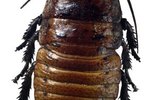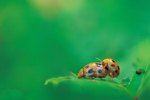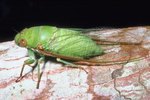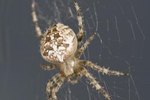
Millions of insects roam the earth with nearly 1 million named extant species. Their roles on earth are pivotal to the survival of plant and animal alike and include predators, prey, decomposers, pollinators and, unfortunately, pests. Numerous species feed on crops including vegetables, grains, citrus and nuts. In some cases, large populations can be detrimental. Of the 30-some orders of insects, only a handful are considered agricultural pests.
Beetles
The order Coleoptera houses several families of crop-destroying pests. Beetles aren't only pests during one phase of life, as many are destructive during their larval and adult stages. Many white grubs that feed on plant roots are the larvae of scarab beetles (Scarabaeidae) including Japanese and May beetles. Leaf beetles belong to the family Chrysomelidae and include the pestilent corn rootworms and flea beetles. Click beetles (Elateridae) are more economically important in the larval forms: the damaging wireworms are a member of this family.
Butterflies and Moths
Butterflies and moths are known more for their pollinating behaviors than destructiveness; their larvae, on the other hand, can cause severe damage to crops depending on the species. Noctuidae moths include the crop-destroying armyworms, bollworms, cutworms and loopers. Other crop pests include the family Sphingidae, commonly known as hawk moths, hummingbird moths or sphinx moths. As adults, many members of this family bear a striking resemblance to hummingbirds. Larvae sphinx moths include the large, light-green tobacco and tomato hornworms that display a prominent, dark-colored spine on their rear.
True Bugs
The true bugs belong to the order Hemiptera. Members of this order have piercing mouthparts which allow them to suck the sap and juices out of their preferred host plants. Stink bugs are members of this order and can be severe pests of many crops, especially soybeans. Other members of Hemiptera include aphids, leafhoppers, cicadas and whiteflies. Aphids are tiny insects that commonly become pests of ornamentals and home vegetable crops, among others.
Maggots
The order Diptera contains the flies. Most flies aren't pests of agricultural crops, but are more likely pests to humans and other animals. The larvae of many fly species feed on decomposing matter including dead animals or decaying plant material. A few species can become agricultural pests, however, including root maggot flies which feed on seeds and roots.
Grasshoppers
Grasshoppers and crickets are closely related. The short-horned grasshoppers in the family Acrididae are among the most detrimental. They prefer to feed on grains including alfalfa, soybean, tobacco, corn and clover. Crickets often inhabit fields and can become nuisances when their numbers reach too high.
References
- North Carolina State University Extension Integrated Pest Management Program: Important Orders and Families of Agricultural Pests
- University of Idaho Integrated Pest Management: Pests of Agricultural Crops - Flea Beetles
- University of Idaho Integrated Pest Management: Pests of Agricultural Crops - Wireworms
- University of Delaware Cooperative Extension: Know Your "True Bugs" That are Pests of Crops
- North Carolina State University Extension Integrated Pest Management Program: Grasshoppers
- University of Michigan Animal Diversity Web: Insecta
- University of Michigan Animal Diversity Web: Insecta Classification
Resources
Photo Credits
-
Hemera Technologies/PhotoObjects.net/Getty Images
Writer Bio
With a professional background in gardening, landscapes, pests and natural ecosystems, Jasey Kelly has been sharing her knowledge through writing since 2009 and has served as an expert writer in these fields. Kelly's background also includes childcare, and animal rescue and care.




